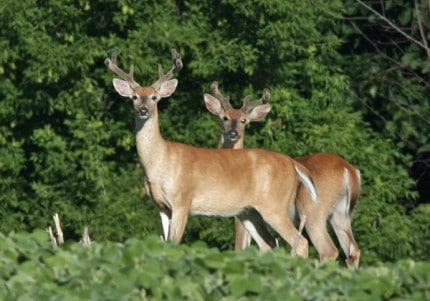
(Chelsea Update would like to thank Tom Hodgson and the Waterloo Natural History Association for the photo and information in this column.)
As odd as this may sound, deer are greenhouse gas factories.
Here’s why. Deer and all domestic cattle are ruminants. They all have four chambered stomachs designed for digesting food high in cellulose. The first chamber called the rumen is strictly for storage. This allows deer to consume large amounts of leaves and grasses (5-7 lbs. per day) in a short period of time. After filling the rumen, they retire to a place of concealment. There the deer bring the food from the rumen back up into their mouths and chew it again in a process called “chewing their cud.”
This time when they swallow, the food goes into the second stomach chamber called the reticulum. The reticulum is loaded with microorganisms that specialize in breaking down cellulose into simpler compounds that can be absorbed and used by the deer. This is accomplished through fermentation.
The deer then bring the food up a second time to be re-chewed once again. This time, when swallowed it goes into the third chamber of the stomach called the omasum where water is absorbed. From there it goes to the fourth chamber of the stomach for further digestion. And finally, the indigestible material that remains goes into the intestines where it is eventually eliminated from the body.
Fermentation produces methane gas which the deer expel by burping. Cattle, sheep and goats do the same. Twenty-five percent of all the methane gas released into the atmosphere in the U.S. comes from cattle, sheep and goats as a by-product of their digestion. No figures are available as to how much methane is actually produced by the wild members of the deer family.
Methane gas is a major contributor to global warming, so I guess it could be argued that hunters are helping to prevent global warming by harvesting deer that would otherwise continue to produce methane gas. Unfortunately, if the deer hunters travel very far to get their deer, the exhaust emissions from their vehicles might contribute more greenhouse gases than would be eliminated by harvesting the deer.
There were more than 280,000 car-deer crashes in Michigan in 2013. That included over 6,000 in Washtenaw County and over 9,000 in Jackson County.
Hunters are expected to take about 400,000 deer during the hunting season this year making them the number one deer predator.
The motor vehicle is unintentionally the number two deer predator.
Number three is the coyote, which primarily kills young fawns, and number four is the wolf, which kills between 14,000 and 28,000 deer per year in the Upper Peninsula. As yet, there are no wolves in the Lower Peninsula. Nor is there a confirmed population of cougar or mountain lion in Michigan. Deer is a preferred prey for the cougar. A single cougar kills an average of 50 deer per year.
Who ever thought that deer would have anything to do with global warming, or for that matter, cattle, sheep and goats would as well? It just shows what a complicated issue global warming is.
In the meantime, good luck to all those hunters in their pursuit of that four-legged, antlered, gas bag — better known as a whitetail deer.



















